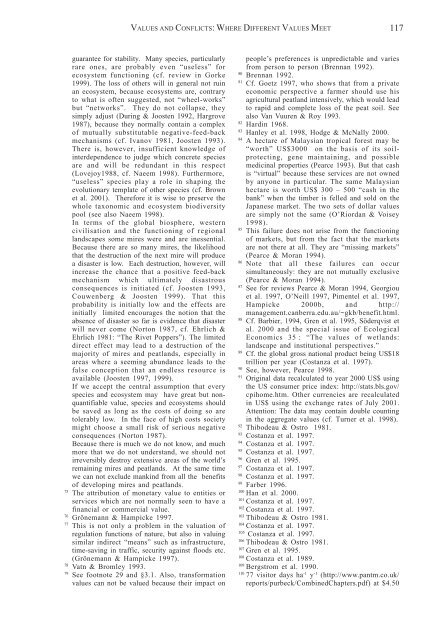wise use of mires and peatlands - Peatland Ecology Research Group
wise use of mires and peatlands - Peatland Ecology Research Group
wise use of mires and peatlands - Peatland Ecology Research Group
You also want an ePaper? Increase the reach of your titles
YUMPU automatically turns print PDFs into web optimized ePapers that Google loves.
VALUES AND CONFLICTS: WHERE DIFFERENT VALUES MEET117guarantee for stability. Many species, particularlyrare ones, are probably even “<strong>use</strong>less” forecosystem functioning (cf. review in Gorke1999). The loss <strong>of</strong> others will in general not ruinan ecosystem, beca<strong>use</strong> ecosystems are, contraryto what is <strong>of</strong>ten suggested, not “wheel-works”but “networks”. They do not collapse, theysimply adjust (During & Joosten 1992, Hargrove1987), beca<strong>use</strong> they normally contain a complex<strong>of</strong> mutually substitutable negative-feed-backmechanisms (cf. Ivanov 1981, Joosten 1993).There is, however, insufficient knowledge <strong>of</strong>interdependence to judge which concrete speciesare <strong>and</strong> will be redundant in this respect(Lovejoy1988, cf. Naeem 1998). Furthermore,“<strong>use</strong>less” species play a role in shaping theevolutionary template <strong>of</strong> other species (cf. Brownet al. 2001). Therefore it is <strong>wise</strong> to preserve thewhole taxonomic <strong>and</strong> ecosystem biodiversitypool (see also Naeem 1998).In terms <strong>of</strong> the global biosphere, westerncivilisation <strong>and</strong> the functioning <strong>of</strong> regionall<strong>and</strong>scapes some <strong>mires</strong> were <strong>and</strong> are inessential.Beca<strong>use</strong> there are so many <strong>mires</strong>, the likelihoodthat the destruction <strong>of</strong> the next mire will producea disaster is low. Each destruction, however, willincrease the chance that a positive feed-backmechanism which ultimately disastrousconsequences is initiated (cf. Joosten 1993,Couwenberg & Joosten 1999). That thisprobability is initially low <strong>and</strong> the effects areinitially limited encourages the notion that theabsence <strong>of</strong> disaster so far is evidence that disasterwill never come (Norton 1987, cf. Ehrlich &Ehrlich 1981: “The Rivet Poppers”). The limiteddirect effect may lead to a destruction <strong>of</strong> themajority <strong>of</strong> <strong>mires</strong> <strong>and</strong> peatl<strong>and</strong>s, especially inareas where a seeming abundance leads to thefalse conception that an endless resource isavailable (Joosten 1997, 1999).If we accept the central assumption that everyspecies <strong>and</strong> ecosystem may have great but nonquantifiablevalue, species <strong>and</strong> ecosystems shouldbe saved as long as the costs <strong>of</strong> doing so aretolerably low. In the face <strong>of</strong> high costs societymight choose a small risk <strong>of</strong> serious negativeconsequences (Norton 1987).Beca<strong>use</strong> there is much we do not know, <strong>and</strong> muchmore that we do not underst<strong>and</strong>, we should notirreversibly destroy extensive areas <strong>of</strong> the world’sremaining <strong>mires</strong> <strong>and</strong> peatl<strong>and</strong>s. At the same timewe can not exclude mankind from all the benefits<strong>of</strong> developing <strong>mires</strong> <strong>and</strong> peatl<strong>and</strong>s.75The attribution <strong>of</strong> monetary value to entities orservices which are not normally seen to have afinancial or commercial value.76Grönemann & Hampicke 1997.77This is not only a problem in the valuation <strong>of</strong>regulation functions <strong>of</strong> nature, but also in valuingsimilar indirect “means” such as infrastructure,time-saving in traffic, security against floods etc.(Grönemann & Hampicke 1997).78Vatn & Bromley 1993.79See footnote 29 <strong>and</strong> §3.1. Also, transformationvalues can not be valued beca<strong>use</strong> their impact onpeople’s preferences is unpredictable <strong>and</strong> variesfrom person to person (Brennan 1992).80Brennan 1992.81Cf. Goetz 1997, who shows that from a privateeconomic perspective a farmer should <strong>use</strong> hisagricultural peatl<strong>and</strong> intensively, which would leadto rapid <strong>and</strong> complete loss <strong>of</strong> the peat soil. Seealso Van Vuuren & Roy 1993.82Hardin 1968.83Hanley et al. 1998, Hodge & McNally 2000.84A hectare <strong>of</strong> Malaysian tropical forest may be“worth” US$3000 on the basis <strong>of</strong> its soilprotecting,gene maintaining, <strong>and</strong> possiblemedicinal properties (Pearce 1993). But that cashis “virtual” beca<strong>use</strong> these services are not ownedby anyone in particular. The same Malaysianhectare is worth US$ 300 – 500 “cash in thebank” when the timber is felled <strong>and</strong> sold on theJapanese market. The two sets <strong>of</strong> dollar valuesare simply not the same (O’Riordan & Voisey1998).85This failure does not arise from the functioning<strong>of</strong> markets, but from the fact that the marketsare not there at all. They are “missing markets”(Pearce & Moran 1994).86Note that all these failures can occursimultaneously: they are not mutually exclusive(Pearce & Moran 1994).87See for reviews Pearce & Moran 1994, Georgiouet al. 1997, O’Neill 1997, Pimentel et al. 1997,Hampicke 2000b, <strong>and</strong> http://management.canberra.edu.au/~gkb/benefit.html.88Cf. Barbier, 1994, Gren et al. 1995, Söderqvist etal. 2000 <strong>and</strong> the special issue <strong>of</strong> EcologicalEconomics 35 : “The values <strong>of</strong> wetl<strong>and</strong>s:l<strong>and</strong>scape <strong>and</strong> institutional perspectives.”89Cf. the global gross national product being US$18trillion per year (Costanza et al. 1997).90See, however, Pearce 1998.91Original data recalculated to year 2000 US$ usingthe US consumer price index: http://stats.bls.gov/cpihome.htm. Other currencies are recalculatedin US$ using the exchange rates <strong>of</strong> July 2001.Attention: The data may contain double countingin the aggregate values (cf. Turner et al. 1998).92Thibodeau & Ostro 1981.93Costanza et al. 1997.94Costanza et al. 1997.95Costanza et al. 1997.96Gren et al. 1995.97Costanza et al. 1997.98Costanza et al. 1997.99Farber 1996.100Han et al. 2000.101Costanza et al. 1997.102Costanza et al. 1997.103Thibodeau & Ostro 1981.104Costanza et al. 1997.105Costanza et al. 1997.106Thibodeau & Ostro 1981.107Gren et al. 1995.108Costanza et al. 1989.109Bergstrom et al. 1990.11077 visitor days ha -1 y -1 (http://www.pantm.co.uk/reports/purbeck/CombinedChapters.pdf) at $4.50
















